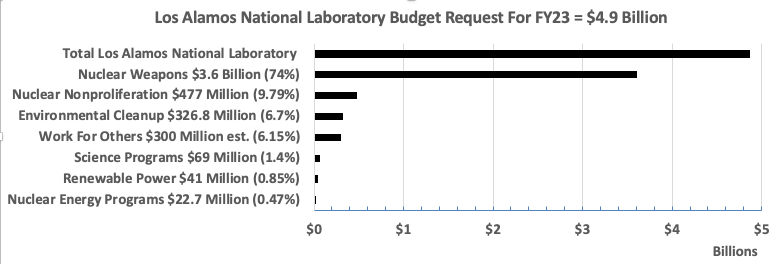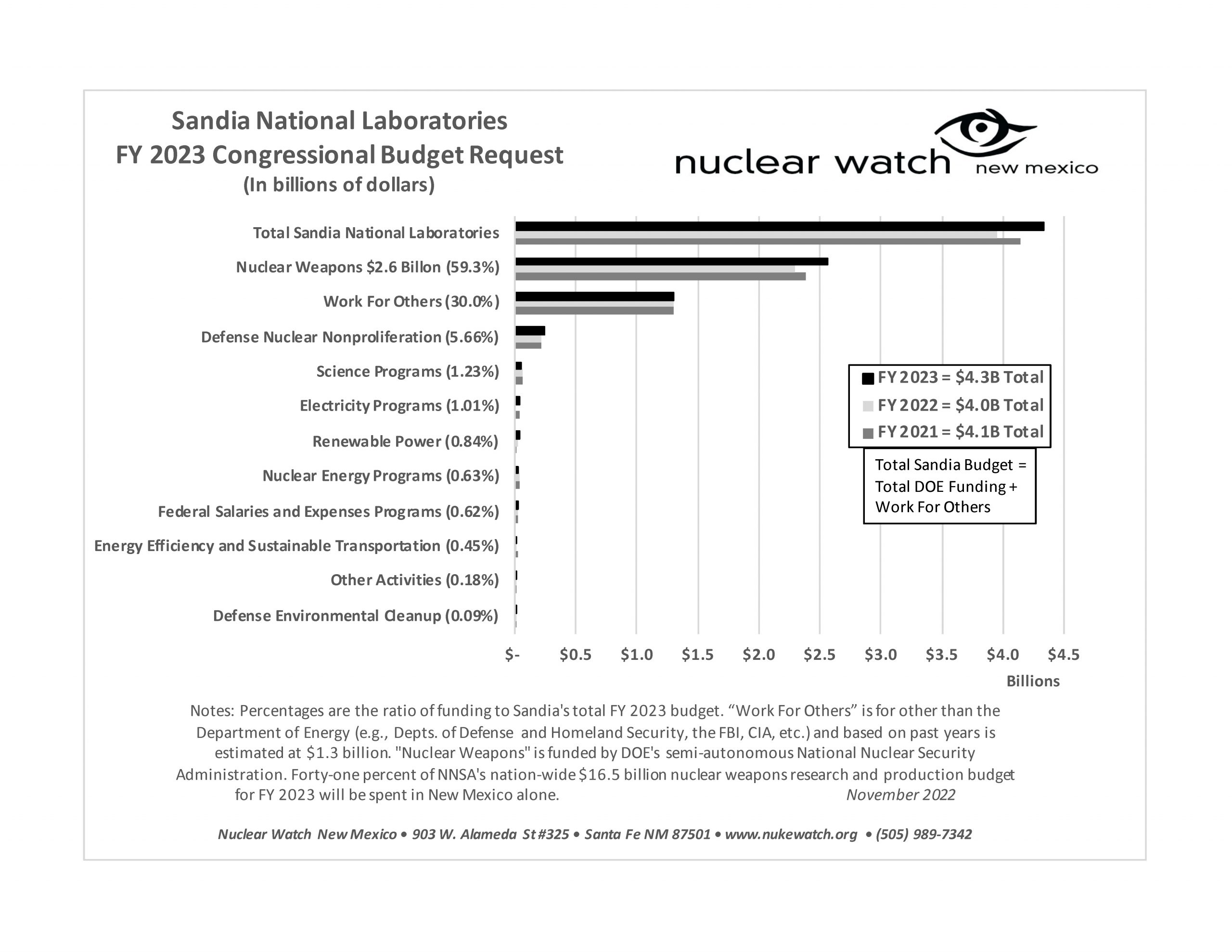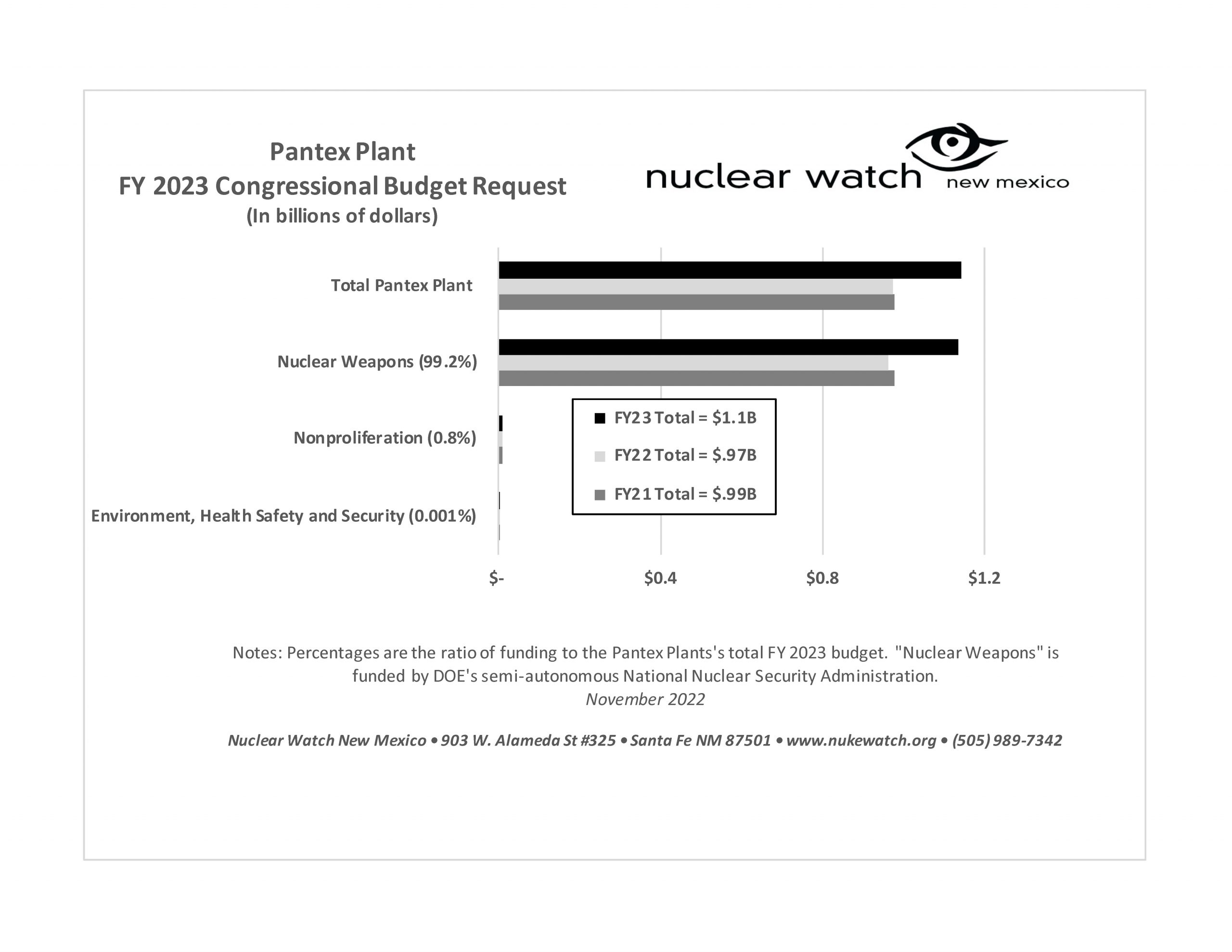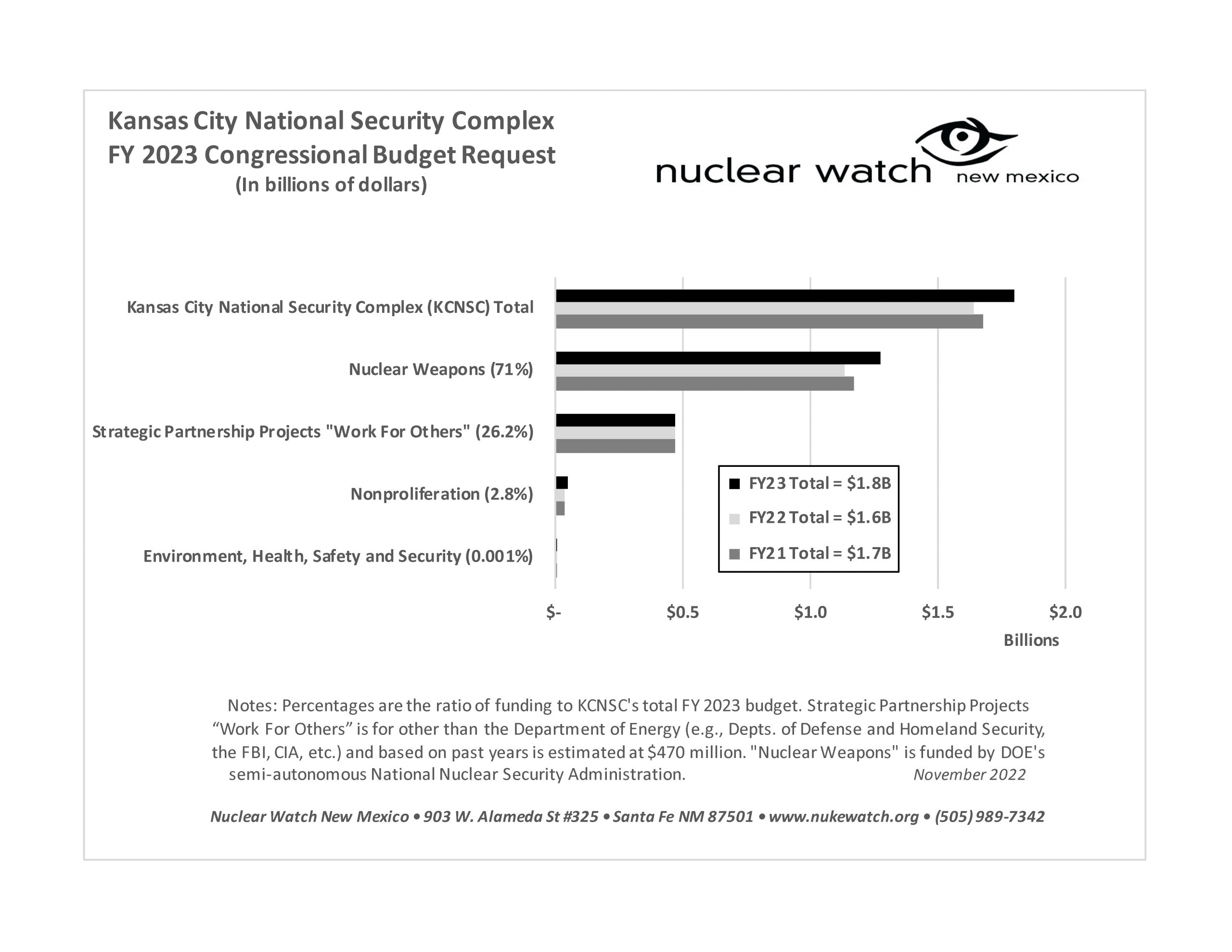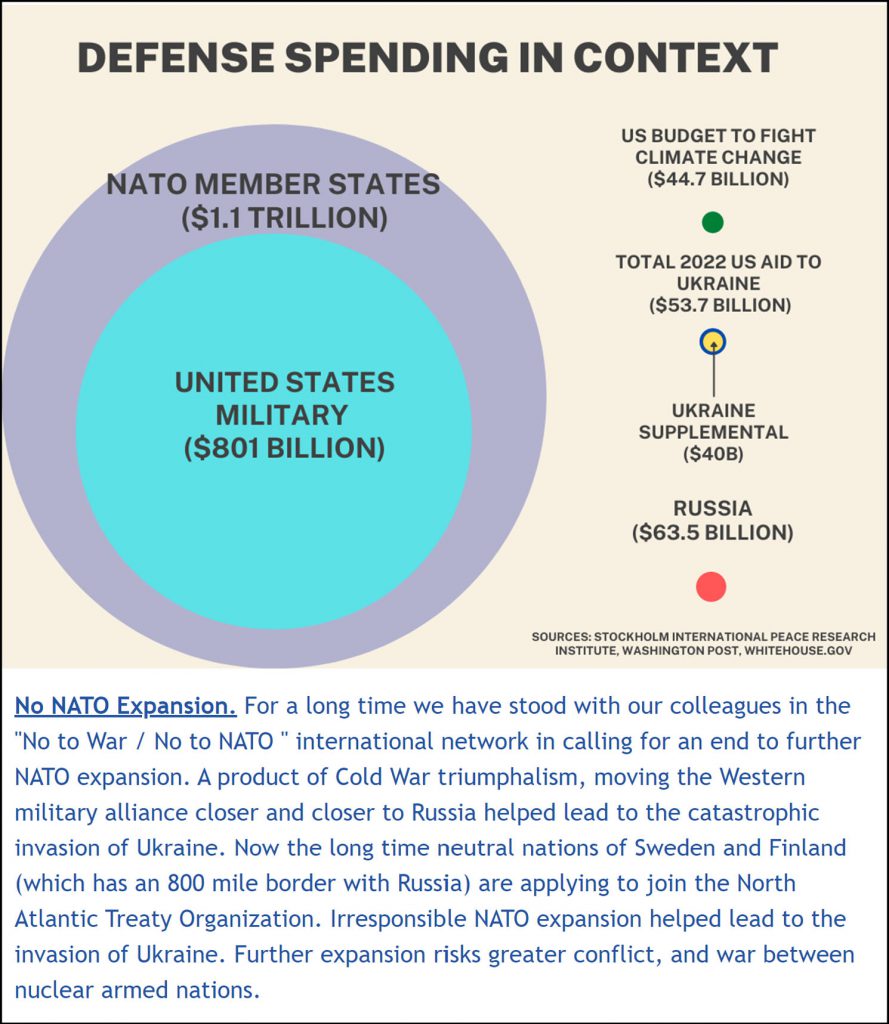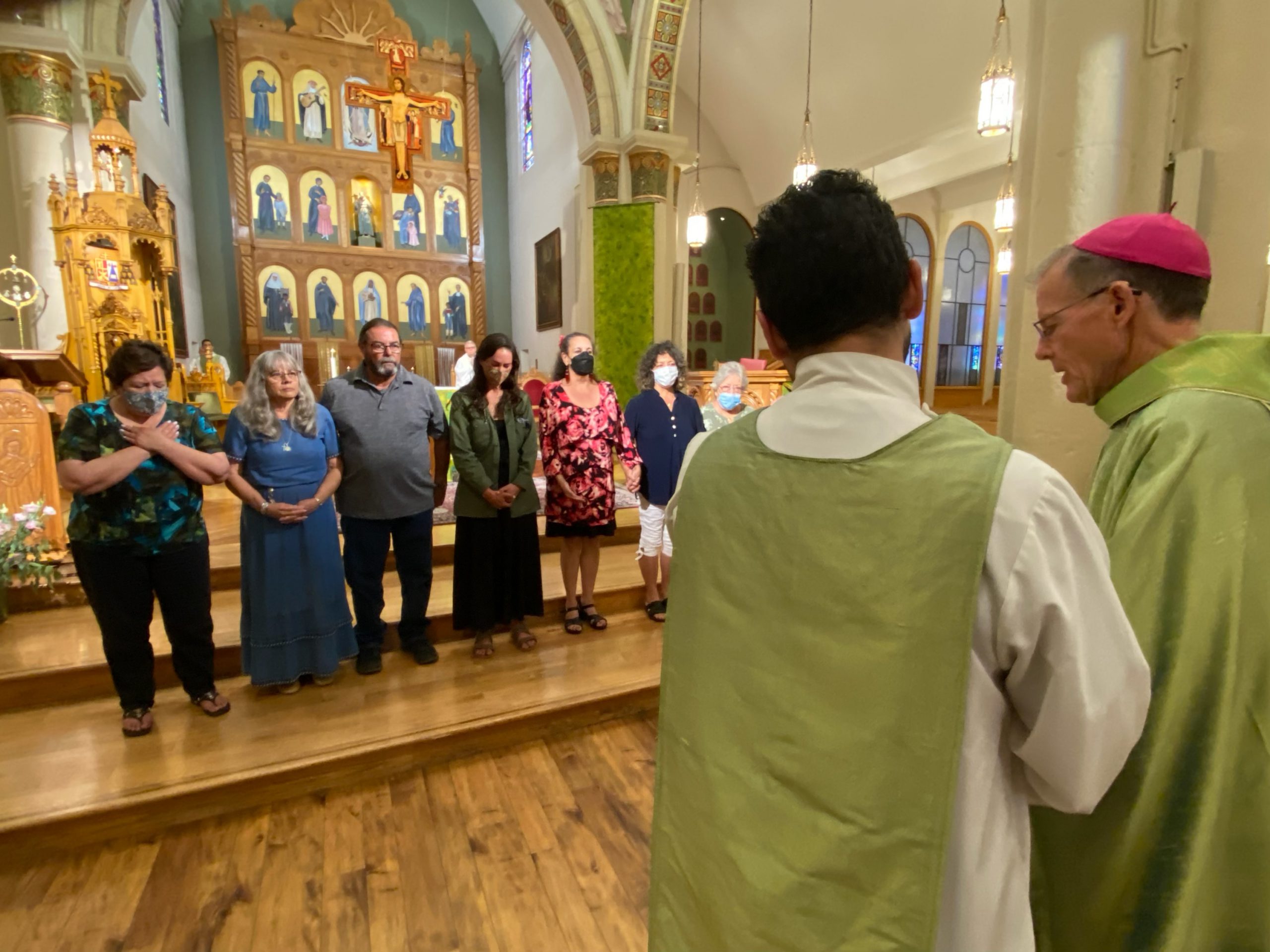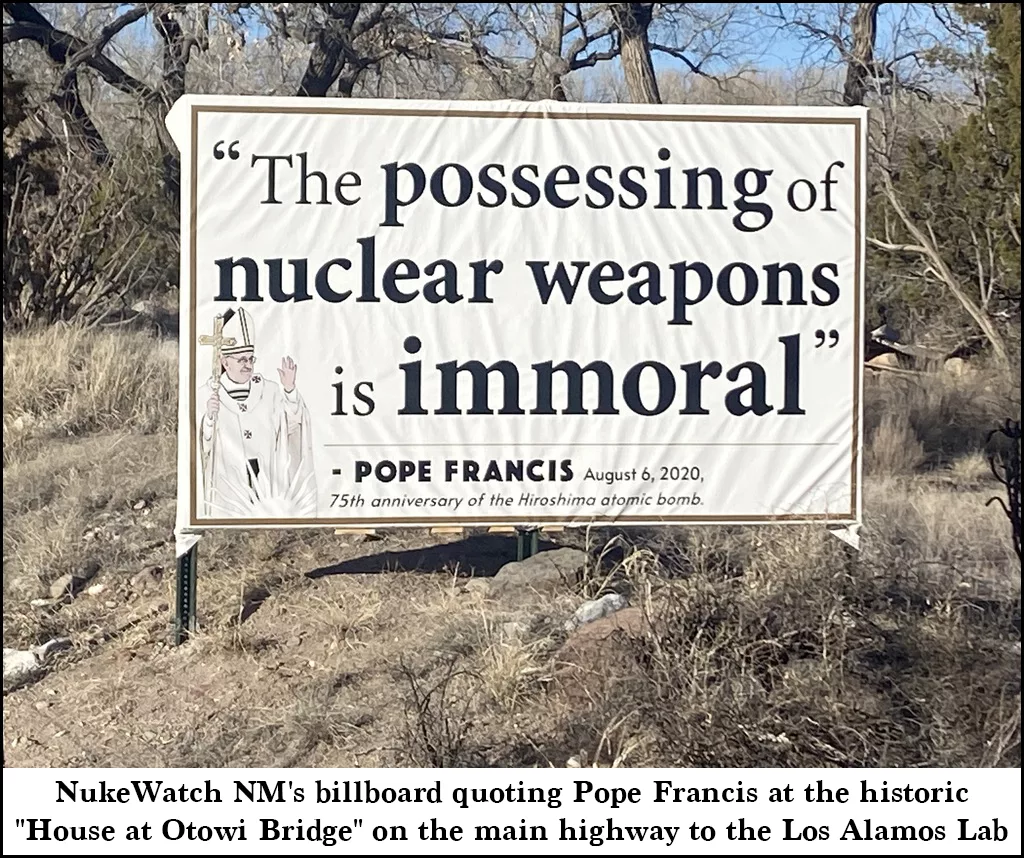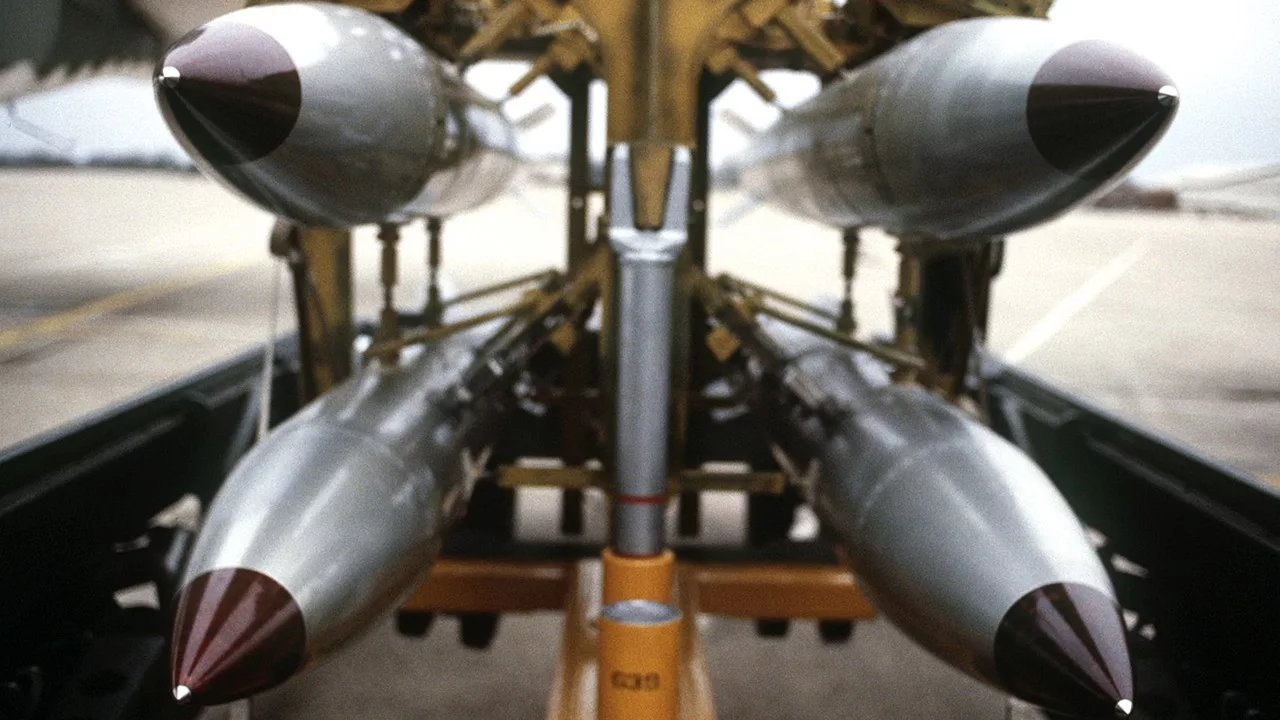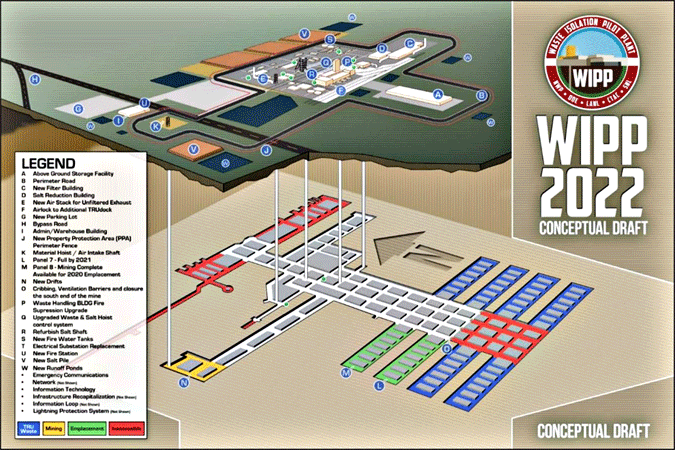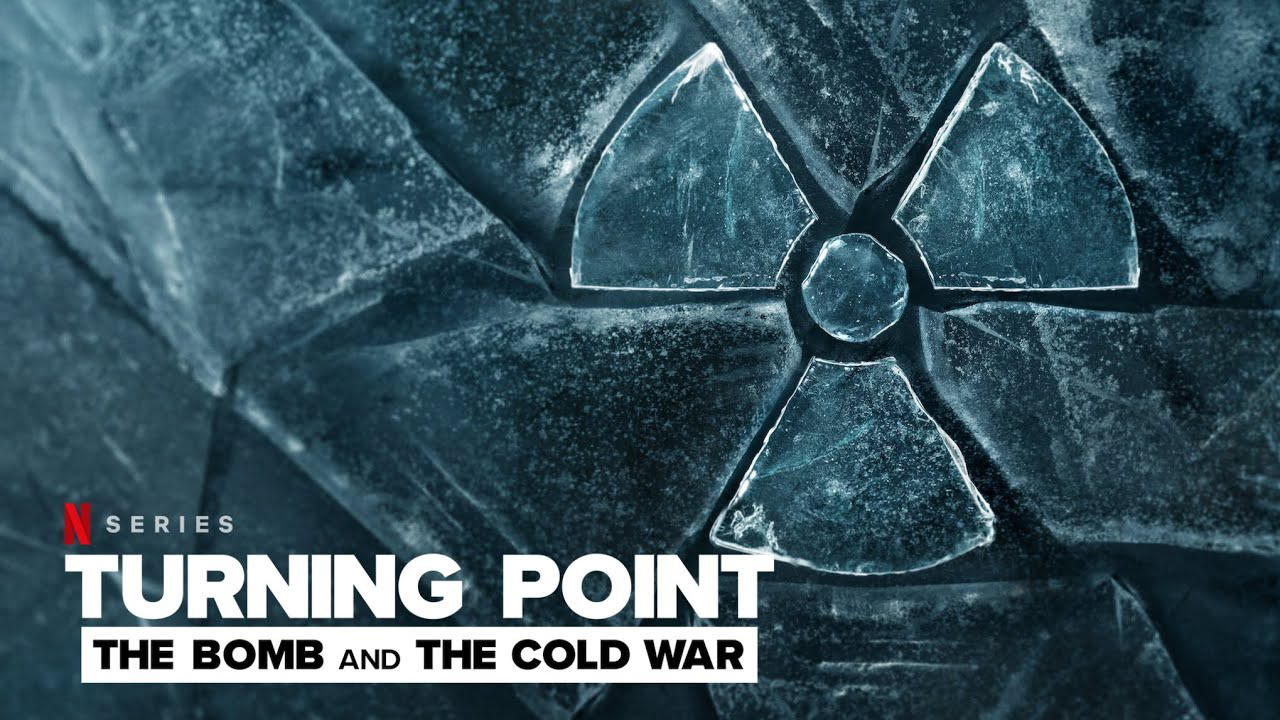QUOTE OF THE WEEK
Nothing Found
It seems we can’t find what you’re looking for. Perhaps searching can help.
LANL’s Central Mission: Los Alamos Lab officials have recently claimed that LANL has moved away from primarily nuclear weapons to “national security”, but what truly remains as the Labs central mission? Here’s the answer from one of its own documents:
LANL’s “Central Mission”- Presented at: RPI Nuclear Data 2011 Symposium for Criticality Safety and Reactor Applications (PDF) 4/27/11
Banner displaying “Nuclear Weapons Are Now Illegal” at the entrance in front of the Los Alamos National Lab to celebrate the Entry Into Force of the Nuclear Weapon Ban Treaty on January 22, 2021
Nothing Found
It seems we can’t find what you’re looking for. Perhaps searching can help.
Follow the Money!
Map of “Nuclear New Mexico”
Nuclear Watch Interactive Map – U.S. Nuclear Weapons Complex
In 1985, US President Ronald Reagan and and Russian President Mikhail Gorbachev declared that “a nuclear war cannot be won and must never be fought.”

Waste Lands: America’s Forgotten Nuclear Legacy
The Wall St. Journal has compiled a searchable database of contaminated sites across the US. (view)
Related WSJ report: https://www.wsj.com
2022 BLOG POSTS
Watchdogs File Suit for NNSA’s Performance Evaluation Reports

 Santa Fe, NM – Today, Nuclear Watch New Mexico has once again filed a lawsuit to pry loose the National Nuclear Security Administration’s (NNSA’s) full and complete Performance Evaluation Reports that evaluate contractor performance at its eight nuclear weapons sites. Approximately 57,000 people are employed by NNSA’s nuclear weapons production complex, 95% of them contractor personnel. NNSA and its parent Department of Energy have been on the independent Government Accountability Office’s “High Risk List” for project mismanagement and waste of taxpayers’ dollars since 1992.
Santa Fe, NM – Today, Nuclear Watch New Mexico has once again filed a lawsuit to pry loose the National Nuclear Security Administration’s (NNSA’s) full and complete Performance Evaluation Reports that evaluate contractor performance at its eight nuclear weapons sites. Approximately 57,000 people are employed by NNSA’s nuclear weapons production complex, 95% of them contractor personnel. NNSA and its parent Department of Energy have been on the independent Government Accountability Office’s “High Risk List” for project mismanagement and waste of taxpayers’ dollars since 1992.
NNSA’s Performance Evaluation Reports grade contractor performance, award performance fees and contain no classified information. Nevertheless, NNSA seeks to hide how taxpayers’ money is spent from the public, issuing only terse three page summaries instead of the full and complete Reports. Nuclear Watch sued in 2012 to obtain the full and complete Performance Evaluation Reports, after which NNSA started releasing them within three working days. But NNSA has again been releasing only summaries since 2019, despite a Freedom of Information Act request by Nuclear Watch that the agency never responded to.
To illustrate the importance of these Performance Evaluation Reports, in its FY 2021 Los Alamos Lab summary NNSA noted that the contractor “[s]ucessfully made advances in pit production processes…” Plutonium “pits” are the fissile cores of nuclear weapons whose expanded production the Pentagon has identified as the number one issue in the United States’ $2 trillion nuclear weapons “modernization” program. NNSA has directed the Los Alamos National Laboratory (LANL) to begin producing at least 30 pits per year by 2026 and the Savannah River Site (SRS) in South Carolina to begin producing at least 50 pits per year by 2030.
A Guide to “Scoping” the New LANL SWEIS
“Scoping” means determining the issues that should be included in public analyses required by the National Environmental Policy Act (NEPA) of proposed major actions by the federal government. According to the Department of Energy ‘s own NEPA implementation regulations, DOE must prepare a new or supplemental site-wide environmental impact statement (SWEIS) for its major sites when there are “significant new circumstances or information relevant to environmental concerns.” The last site-wide EIS for the Los Alamos National Laboratory (LANL) was completed in 2008 and is badly outdated. Moreover, since 2018 the National Nuclear Security Administration (NNSA), DOE’s semi-autonomous nuclear weapons agency, has been aggressively expanding the production of plutonium “pit” bomb cores for nuclear weapons at the Lab.
On August 19, 2022, NNSA finally announced its intent to prepare a new LANL SWEIS, but apparently the agency will not address expanded plutonium pit production.1 NNSA’s dubious argument is that it performed the legally required NEPA analysis for expanded plutonium pit production in a 2008 Complex Transformation Programmatic Environmental Impact Statement, the 2008 LANL SWEIS and a woefully inadequate “Supplement Analysis” in 2020 that concluded a new SWEIS was not needed. 2 3
Issues That Must Be Addressed in a New LANL SWEIS
This is meant to be a guide to (or list of) the issues that must be addressed in a new draft LANL SWEIS. It is not completely exhaustive, nor is it a comprehensive fact sheet on the substance of the issues. Nuclear Watch New Mexico will offer suggested scoping comments for interested citizens and submit its own comprehensive formal comments before the October 3 deadline or extended deadline (see “Timing” below).
New & Updated
NNSA issues plans to assess pits environmental impact
“This programmatic environmental impact statement that we fought long and hard for empowers citizens to tell policy makers what they think about decisions being made in their name,” Jay Coghlan, from environmentalist group Nuclear Watch New Mexico, said Thursday in a press release by the plaintiffs of the case. “Let them know what you think about the $2 trillion ‘modernization’ program to keep nuclear weapons forever while domestic programs are gutted to pay for tax cuts for the rich.”
By ExchangeMonitor | May 9, 2025 exchangemonitor.com
On the heels of a federal judge’s ruling last fall, the Department of Energy’s National Nuclear Security Administration formally announced plans Friday for a detailed review of environmental impacts of planned plutonium pit production.
DOE’s semi-autonomous National Nuclear Security Administration (NNSA) announced in the Federal Register it is kicking off a programmatic environmental impact statement EIS to ensure that large-scale pit production will comply with the National Environmental Policy Act (NEPA).
According to the Federal Register notice, NNSA will hold public meetings and public hearings as part of the process.
Two online public scoping meetings are now scheduled for May 27 and May 28. The May 27 session would commence at 5 p.m. Eastern Time while the May 28 one is scheduled to start at 7 p.m. Eastern. Both can be accessed online or by phone. Details can be found in the Federal Register notice.
A federal district judge ruled last September that DOE and NNSA did not adequately analyze the environmental effects of producing the radioactive cores that trigger nuclear weapons in two different states, but declined to put the pit program, including construction of the Savannah River Plutonium Processing Facility at Aiken, S.C.’s Savannah River Site on hold as a result. In January, the federal government and the plaintiffs, consisting of environmentalists, settled the lawsuit and agreed to leave Los Alamos National Laboratory as the sole pit factory until NNSA completes a nationwide, NEPA-compliant programmatic EIS.Continue reading
US nuclear firm ‘utterly crucial’ to national security expands East Tennessee operations
“Which company produces uranium fuel for U.S. Navy nuclear reactors and manages the only plant where the government disassembles atomic warheads? What about the company helping NASA to develop a nuclear rocket, all while building small modular reactors and developing a pilot plant to restart uranium enrichment for the military?”
By Daniel Dassow, Knoxville News Sentinel | May 5, 2025 newsbreak.com
It’s all the same answer: BWX Technologies , the $2.7 billion juggernaut better known as BWXT has embedded itself in every kind of nuclear project imaginable with a strong and growing presence in East Tennessee, where 1,100 employees at its Nuclear Fuel Services plant in Erwin “downblend” bomb-grade uranium. The facility also creates fuel for the nuclear reactors aboard U.S. Navy submarines and aircraft carriers.
The region is even more important to BWXT after it bought a specialized facility in Jonesborough and 97 acres in Oak Ridge for a centrifuge enrichment project the company says will create hundreds of jobs through millions of dollars in investments.
“We have availed ourselves as a key player in just about every interesting nuclear opportunity that you can think of,” BWXT President and CEO Rex Geveden told Knox News. “We’re all over it.”
BWXT is part of the team led by the Tennessee Valley Authority to build the first small modular nuclear reactors in the U.S. at the federal utility’s Clinch River Nuclear Site in Oak Ridge .
It will manufacture the reactor pressure vessel, the largest component of the 300-megawatt reactor designed by GE Hitachi Nuclear Energy , for small modular reactors in the U.S. and Canada.
Curb the Skyrocketing Cost of U.S. Nuclear Modernization
“Since Russia and the United States agreed 15 years ago to modest nuclear reductions under the New Strategic Arms Reduction Treaty (New START), they also have embarked on extraordinarily expensive campaigns to replace and modernize every component of their respective nuclear arsenals to maintain force levels and provide the option to build up.”
By Daryl G. Kimball, Arms Control Today | May 1, 2025 newsbreak.com
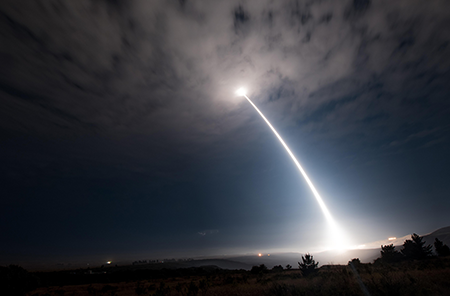
At the same time, their leaders have failed to resolve disputes about existing treaties or launch new negotiations to limit or further cut their deadly arsenals below the New START ceiling of 1,550 deployed nuclear warheads and 700 strategic missiles and bombers each.
In 2018, shortly after he withdrew the United States from the Intermediate-Range Nuclear Forces Treaty, U.S. President Donald Trump foolishly bragged about the nuclear stockpile that “until people come to their senses, we will build it up. It’s a threat to whoever you want, and it includes China, and it includes Russia, and it includes anybody else that wants to play that game.”
China has responded to U.S. nuclear and conventional military plans by pursuing a buildup of its historically “minimal” nuclear force to ensure that it retains an assured “second strike” capability. Russia has continued to develop new types of intermediate range missiles, as well as some new and exotic strategic systems designed to bypass U.S. missile defense capabilities.
Successive presidential administrations and congresses have failed to seriously consider alternatives that would have reduced costs and still maintained a devastating nuclear force.
Now, the cost of the U.S. nuclear modernization program is skyrocketing even further, siphoning resources from other more pressing human needs and national security priorities.
In April, the Congressional Budget Office issued its latest 10-year cost projection of the departments of Defense and Energy plans to operate, sustain, and modernize existing U.S. nuclear forces and purchase new forces: a total of $946 billion in the 2025-2034 period, or about $95 billion per year.
This new estimate is 25 percent, or $190 billion, greater than the last CBO estimate of $756 billion, which covered the 2023-2032 period. Incredibly, the $946 billion estimate does not include all of the likely cost growth of the new Sentinel intercontinental ballistic missile program, which the Pentagon acknowledged in July 2024 would cost 81 percent, or $63 billion, more than the program’s baseline estimate of $78 billion, generated in 2020.
Find Out the Facts & Sign the Petition: Why NMED Should Deny LANL’s Request for Tritium Releases
Why NMED Should Deny LANL’s Request for Tritium Releases
The Los Alamos National Laboratory plans to begin large releases of radioactive tritium gas any time after June 2, 2025. The only roadblock to the Lab’s plans is that it needs a “Temporary Authorization” from the New Mexico Environment Department to do so.
Reasons why NMED should deny LANL’s request are:
- The state Environment Department has a duty to protect the New Mexican As it states, “Our mission is to protect and restore the environment and to foster a healthy and prosperous New Mexico for present and future generations.” 1
- Why the rush? LANL explicitly admits there is no urgency. According to the Lab’s publicly-released “Questions and Answers” in response to “What is the urgency for this project?”
“There is no urgency for this project beyond the broader mission goals to reduce onsite waste liabilities.” 2
-
- In addition, the National Nuclear Security Administration (NNSA) admits that the end time frame for action is 2028, not 2025.3 Therefore, there is time for deliberate consideration.
- Contrary to NMED’s Resource Conservation and Recovery Act permit for LANL, the Lab has not fulfilled its duty to inform the public via NMED of possible alternatives to its planned tritium releases.4 According to Tewa Women United, “LANL has told EPA there are 53 alternatives; that list of alternatives, initially requested in 2022, has not yet been Tewa Women United has repeatedly asked LANL to provide the public with that list.” 5
University of New Mexico to host exhibit on nuclear history, technology, weapons
ALBUQUERQUE, N.M. (KRQE) — A provocative international exhibit will open soon at the University of New Mexico. “the bomb” is an immersive, multi-media installation exploring the history, technology, and threat of nuclear weapons.
By Nicole Sanders, KRQE | April 22, 2025 krqe.com
The installation includes an hour-long film projected on 45 screens conveying the hidden chaos and danger of the nuclear age. The experience is coming to UNM from April 30 to May 30. The full schedule at Zimmerman Library is available below:
- Wednesday, April 30
- Friday, May 2, 2025
- Friday, May 9, 2025
- Friday, May 16, 2025
- Friday, May 23, 2025
- Friday, May 30, 2025
Formal Comments on the Draft Site-Wide Environmental Impact Statement for Continued Operation of the Los Alamos National Laboratory
The National Environmental Policy Act requires the Los Alamos National Laboratory to periodically prepare a new “Site-Wide Environmental Impact Statement (SWEIS) for Continued Operations.”
Please use NukeWatch NM’s recent extensive comments on the Lab’s new draft SWEIS as a resource and citizens’ guide to Lab issues.
Did you know, for example, that:
• LANL’s nuclear weapons production budget has doubled over the last decade?
• The Lab’s so-called cleanup plan is to “cap and cover” some 200,000 cubic yards of radioactive and toxic waste, leaving them permanently buried as a perpetual threat to groundwater?
• There is a planned intentional release of up to 30,000 curies of radioactive tritium gas, all without a public hearing?
Use our lengthy formal comments as a starting point, toolkit or resource for dissecting ongoing and future issues at LANL!
We encourage you to use our comments to ask for follow-up info, either from us here at NukeWatch or from the Lab, and to demand better accountability and transparency! Use as background or briefing material for local and congressional advocacy.
For example:
- Cite or excerpt our comments in future public processes under the National Environmental Policy Act. For example, we are expecting that a nationwide programmatic environmental impact statement for plutonium “pit” bomb core production will be announced soon, the result of a lawsuit in which NukeWatch led.
- Share with those organizing around stopping expanded plutonium pit production and advocating for genuine radioactive and toxic wastes cleanup.
- Learn about LANL’s proposed electrical transmission line across the environmentally and culturally sensitive Caja del Rio and alternatives that were not considered.
- The National Environmental Policy Act itself is under assault by the Trump Administration. We expect environmental justice and climate change issues to be stripped from LANL’s final Site-Wide Environmental Impact Statement. This needs to be resisted!
NukeWatch NM argued that the draft SWEIS should be withdrawn and a new one issued because:
• The NNSA has rigged the draft LANL Site-Wide EIS with three self-serving scenarios:
– Expanded nuclear weapons programs (contradictorily called the “No Action Alternative”).
– Yet more expanded nuclear weapons programs (“Modernized Operations Alternative”).
– Yet far more expanded nuclear weapons programs (“Expanded Operations Alternative”).
• A Reduced Operations Alternative must be included.
• The SWEIS’ fundamental justification for expanded nuclear weapons programs is “deterrence.” But “deterrence” has always included nuclear warfighting capabilities that could end human civilization overnight.
• The SWEIS purports to align with U.S. obligations under the 1970 NonProliferation Treaty. That is demonstrably false.
• Future plutonium pit production is NOT to maintain the safety and reliability of the existing nuclear weapons stockpile. Instead, it is for new-design nuclear weapons that could lower confidence in stockpile reliability and/or prompt a return to testing.
• The SWEIS’ No-Action Alternative violates the National Environmental Policy Act (NEPA).
• The legally required programmatic environmental impact statement on pit production should be completed first, followed by the LANL SWEIS.
• Plutonium pit reuse should be analyzed as a credible alternative to pit production.
• A recent proposal for a data center at LANL is not in the SWEIS. It raises huge issues of future water and electrical use, the appropriateness of commercial interests at a federal lab, and the possible fusion of artificial intelligence and nuclear weapons command and control.
• Recent Executive Orders could strip the final SWEIS of environmental justice and climate change analyses. This must have clarification.
• Planned tritium releases should be fully analyzed.
• The Electrical Power Capacity Upgrade should be analyzed will all credible alternatives.
• The proposed BioSafety Level-3 facility must have its own standalone EIS.
• All Defense Nuclear Facilities Safety Board concerns should be addressed and resolved.
• Genuine comprehensive cleanup should be a preferred alternative.
• A new SWEIS should follow a new overdue Probabilistic Seismic Hazard Analysis.
Nuclear Weapons Issues & The Accelerating Arms Race: April 2025
Nuclear weapons
Air Force Weighs Keeping 1970s-Era Missiles Until 2050
The US Air Force is considering contingency plans that would extend the life of 1970s-era intercontinental ballistic missiles by 11 more years to 2050 if delays continue to plague the new Sentinel models intended to replace them. The current plan is to remove all 400 Minuteman III ICBMs made by Boeing Co. from silos by 2039… The Sentinel was projected last year to be deployed starting in May 2029. The first test flight was once projected for December 2023, but fiscal 2025 budget documents indicated a slip to February 2026.
The estimated cost of the new Sentinel intercontinental ballistic missiles (ICBM), originally at ~$110 billion, is now north of $180 billion. And this is before recognition of the immensity of supplying new command and control communications and recent consideration that its hardened silos may have to be replaced. IMHO it’s a propitious time to argue again for eliminating the land-based ICBM leg of the Triad. After all, one of its stated purposes is to act as a “nuclear sponge” for incoming Russian warheads. The odds of that are not zero and may increase if ICBMs are uploaded with multiple warheads after the New Strategic Arms Reduction Treaty expires in February 2026. More temptation for a preemptive first strike.
Calls to restart nuclear weapons tests stir dismay and debate among scientists
By Emily Conover, Science News | March 27, 2025 sciencenews.org
When the countdown hit zero on September 23, 1992, the desert surface puffed up into the air, as if a giant balloon had inflated it from below.
It wasn’t a balloon. Scientists had exploded a nuclear device hundreds of meters below the Nevada desert, equivalent to thousands of tons of TNT. The ensuing fireball reached pressures and temperatures well beyond those in Earth’s core. Within milliseconds of the detonation, shock waves rammed outward. The rock melted, vaporized and fractured, leaving behind a cavity oozing with liquid radioactive rock that puddled on the cavity’s floor.
As the temperature and pressure abated, rocks collapsed into the cavity. The desert surface slumped, forming a subsidence crater about 3 meters deep and wider than the length of a football field. Unknown to the scientists working on this test, named Divider, it would be the end of the line. Soon after, the United States halted nuclear testing.
Beginning with the first explosive test, known as Trinity, in 1945, more than 2,000 atomic blasts have rattled the globe. Today, that nuclear din has been largely silenced, thanks to the norms set by the Comprehensive Nuclear-Test-Ban Treaty, or CTBT, negotiated in the mid-1990s.
Only one nation — North Korea — has conducted a nuclear test this century. But researchers and policy makers are increasingly grappling with the possibility that the fragile quiet will soon be shattered.
Some in the United States have called for resuming testing, including a former national security adviser to President Donald Trump. Officials in the previous Trump administration considered testing, according to a 2020 Washington Post article. And there may be temptation in coming years. The United States is in the midst of a sweeping, decades-long overhaul of its aging nuclear arsenal…
Nuclear Nightmare: Meet America’s New B61-12 Gravity Bomb
What makes the B61-12 particularly impressive is the bomb’s ability to adjust its destructive yield depending on the operational conditions and demands.
By Stavros Atlamazoglou, National Interest | March 26, 2025 nationalinterest.org
Over the past months, the U.S. Air Force added another potent weapon to its arsenal: a new nuclear bomb, having recently completed production at Sandia National Laboratories in Albuquerque, New Mexico.
The B61-12 nuclear gravity bomb achieved full system production recently and is now fully operational. The nuclear bomb is one of the most versatile munitions of its type in the world, and a useful addition to the U.S. military’s nuclear deterrent capabilities.
The B61-12’s Unique Variable Yield Design
Sandia, one of the three main research and development laboratories for nuclear munitions, completed the production of the B61-12 nuclear gravity bomb. The nuclear munition is now fully operational.
What makes the B61-12 particularly impressive is the bomb’s ability to adjust its destructive yield depending on the operational conditions and demands. Put simply, the B61-12 is four bombs in one. The nuclear munition can be adjusted to four different yields—0.3, 1.5, 10, or 50 kilotons. The difference in yields means that the B61-12 has tactical, operational, and potentially even strategic utility.
Eight decades of nuclear threats are too much
Santa Fe New Mexican: My View John C. Wester
By John Wester, The Santa Fe New Mexican | March 15, 2025 santafenewmexican.com
I am John C. Wester, Archbishop of Santa Fe. I’m speaking on behalf of my archdiocese, and the archbishop of Seattle, the bishop of Hiroshima, and the archbishop of Nagasaki. We take guidance from our Holy Father, Pope Francis, who has declared the very possession of nuclear weapons to be immoral. We pray for his health.
Two years ago, in Nagasaki, on the 78th anniversary of its atomic bombing, we Catholic leaders formally created the Partnership for a World without Nuclear Weapons. Our four dioceses include the birthplace of nuclear weapons, the most deployed weapons in the United States, and the only two cities that to date have suffered atomic bombings. We lend our voices in staunch support of the Treaty on the Prohibition of Nuclear Weapons, at this Third Meeting of State Parties.
In July 2017, the Vatican was the first nation-state to sign and ratify the treaty. We note that the nuclear weapons powers have never honored their long-held obligations, under the 1970 Non-Proliferation Treaty, to enter into serious negotiations leading to global nuclear disarmament.
In contrast, the entry into force of the ban treaty was a great step toward the light of peace. The nuclear armed states have a moral obligation to hear the voices of the majority of the world, and to listen to those who are threatened by annihilation, at the whim of any one of their nine leaders.
The New York Times: DOGE Cuts Reach Key Nuclear Scientists, Bomb Engineers and Safety Experts
“Firings and buyouts hit the top-secret National Nuclear Security Administration amid a major effort to upgrade America’s nuclear arsenal. Critics say it shows the consequences of heedlessly cutting the federal work force.”
“The department has said that most of the fired employees handled administrative and clerical tasks that were not critical to the agency’s operation. But an analysis of the internal documents by The Times, coupled with interviews with 18 current and former agency officials, shows that is not true for the bulk of people who took the buyout,”
By Sharon LaFraniere, Minho Kim and Julie Tate, The New York Times | March 17, 2025 nytimes.com
…The Times reports that many had top-secret security clearance, giving them access to information on how nuclear weapons are made.
North Korea vows to ‘strengthen’ nuclear capabilities, rejecting G7 call for denuclearization
“The G7 called on Friday for North Korea to “abandon” its nuclear program.”
By Kevin Shalvey, ABC News | March 17, 2025 abcnews.go.com
LONDON — North Korea on Monday vowed to “steadily update and strengthen” its nuclear capabilities, a firm rejection of the G7’s call for Pyongyang to “abandon” its nuclear ambitions.
The country’s Foreign Ministry said that its “nuclear armed forces will exist forever as a powerful means of justice which defends the sovereignty of the state, territorial integrity and fundamental interests,” according to the Korean Central News Agency, a state-run media outlet.
ACTION ALERTS
Endless Nuclear Waste Storage in NM?? Not On Our Watch…
Keep up with the Stop Forever WIPP Coalition to learn how to take action against the Federal Government’s Plan to Expand WIPP and keep it open indefinitely.
Visit the Stop Forever WIPP Coalition’s website and social media:
Website: www.StopForeverWIPP.org
Facebook: facebook.com/StopfvrWIPP
Twitter: twitter.com/stopforeverwipp
Instagram: instagram.com/stopfvrwipp
Stay Informed of All Permit-Related Happenings at WIPP! Sign Up for Updates:
The New Mexico Environment Department maintains a Facility Mailing List to which you can add your name and address to get the latest information – just email Ricardo Maestas at the New Mexico Environment Department at ricardo.maestas@state.nm.us and ask to be added to the list. Or mail your request with your mailing address to:
Continue reading
Nothing Found
It seems we can’t find what you’re looking for. Perhaps searching can help.
Interfaith Panel Discussion on Nuclear Disarmament - August 9
Nothing Found
It seems we can’t find what you’re looking for. Perhaps searching can help.
New Nuclear Media
“Turning Point: The Bomb and the Cold War” Explores Impact of US–Soviet Conflict
The nine-part doc examines how two global superpowers have irrevocably altered the course of history.
By Roxanne Fequiere, Netflix | netflix.com
While the the Cold War ended in 1991, even a casual appraisal of current headlines reveals that relations between the United States and Russia — the one-time center of the Soviet Union — remain tense, to say the least. The global repercussions of the Cold War continue to ripple through the current geopolitical landscape to this day, but it can be difficult to understand just how a mid-20th century struggle for ideological dominance continues to ensnare countless nations in ongoing unrest.




